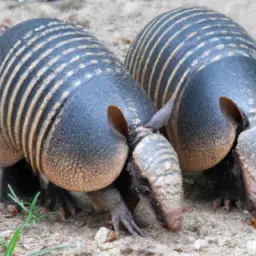Have you ever seen a creature with armor like a knight from the old stories, but small and scurrying across the ground? That’s an armadillo! Today, we’re talking about an interesting question: Do armadillos lay eggs?
You might be wondering about this because armadillos look a bit like those ancient reptiles, but let’s find out what’s going on. In this post, we’ll dive into the world of armadillos, explore their life cycle, and debunk some myths about these unique animals.
Understanding Armadillos: Characteristics and Behavior
What Are Armadillos?
Armadillos are small to medium-sized mammals with a leathery armor shell. They belong to the family Dasypodidae and are known for their distinctive, bony plates that cover their backs.
There are about 20 different species of armadillos, ranging from the tiny pink fairy armadillo to the large, three-banded armadillo.
Where Do Armadillos Live?
Armadillos are pretty interesting critters, and you can mostly find them hanging out in Latin America. A bunch of different types live there, especially in places like Brazil and Argentina.
But here’s a fun fact: the nine-banded armadillo isn’t just staying put in South America. Nope, it’s been slowly but surely moving into the southern United States too. They’re spreading out, making themselves at home from Texas to Florida.
So, if you’re in those parts, keep your eyes peeled—you might just spot one of these armored wanderers on the move!
The Reproductive Habits of Armadillos
How Do Armadillos Reproduce?
Armadillos have a cool trick up their sleeves. Some of them can pause their pregnancy after they mate. It’s like they hit a “hold on” button on having babies.
This isn’t just a neat party trick; it helps them make sure they bring their little ones into the world when the timing is just right. Maybe when the weather’s good or there’s plenty of food around.
This way, their babies have a better shot at growing up strong and healthy. It’s pretty smart, right? This clever strategy lets armadillos adapt to their surroundings and thrive.
Gestation Period and Birth
Armadillos have a unique pregnancy. Take the nine-banded armadillo, for instance. Their pregnancy can last about four months, and guess what? They give birth to live babies, not eggs! That’s right, no eggs at all! These fascinating creatures are full of surprises.
Do Armadillos Lay Eggs?
The Truth About Armadillo Reproduction
It’s a common mix-up, thinking armadillos might lay eggs because of how they look. But here’s the scoop: Armadillos do not lay eggs. Armadillos are mammals, much like us humans or even whales.
That means they have their young one the mammal way—not by laying eggs, but by giving birth to live babies. Their hard, bony shells might make them look more like egg-laying creatures, but don’t let that fool you. No eggs here, just baby armadillos coming into the world ready to explore! So, next time you see one, remember, they’re part of the live birth gang!
Comparing Armadillos to Other Mammals
Unlike birds or reptiles, every mammal gives birth to live babies. This includes our tough-looking buddies, the armadillos. They might have shells like turtles, but don’t get confused—they’re all mammals. Inside their armored bodies, they keep their little ones safe and sound until they’re ready to meet the world.
So, when it’s time, armadillos welcome fully formed, tiny versions of themselves into the great outdoors. No eggs, no hatching, just baby armadillos ready to go from day one! This way, they make sure their babies have the best start in life, protected and nurtured right from the start.
The Lifecycle of an Armadillo
What Happens After Armadillos Are Born?
Right after they’re born, baby armadillos, which we call pups, start their lives in a cozy burrow.
These little ones stick close to their mom, relying on her for protection and food. Just like puppies or kittens, they drink their mom’s milk.
This helps them grow strong and healthy. Over time, as they learn from their mom and start exploring around a bit, they get ready to handle the world on their own.
It’s all about growing up safe in their underground home until they’re ready to venture out.
Growth Stages of Armadillos
Armadillos are quick growers! From the moment they are born, these little creatures start hustling to grow up fast. In just about a year, they’re all grown up and ready to handle the world on their own.
As they grow, their armor gets tougher and covers them better. This isn’t just for looks; it’s their main defense against predators out in the wild.
It’s amazing how these small mammals can grow so fast and toughen up, ready to face whatever comes their way with their built-in shield!
Common Myths About Armadillos

Myth 1: Armadillos Lay Eggs
We’ve already cleared this up, but just in case you’re wondering, armadillos don’t lay eggs. Nope, they give birth to live young. Just like other mammals, armadillos carry their babies and then welcome little mini-mes into the world, all ready to go from the get-go!
Myth 2: Armadillos Are Related to Reptiles
Despite their scaly looks, armadillos aren’t related to reptiles at all—they’re 100% mammal. Their armor might make them seem like ancient creatures or a bit like dinosaurs, but they are more like us than you might think.
They nurse their babies and keep them warm and safe, just as all mammals do. So, don’t let that tough exterior fool you!
How to Spot an Armadillo in the Wild
Physical Characteristics
When trying to spot an armadillo, keep your eyes peeled for their unique armor. It’s not just any shell—it’s a tough, bony covering that makes them stand out.
They have small, pointed heads and long noses, which are perfect for sniffing out food. Their legs are strong and equipped with claws that are great for digging into the earth.
This armor isn’t just for protection; it’s a key part of what makes armadillos special in the animal kingdom.
Behavioral Traits
Armadillos love the nightlife! They’re mostly active at night, which is the best time to catch a glimpse of these interesting creatures.
During the day, they tend to hide from the heat and rest. If you’re up early or out late, you might see them digging around.
They’re on the hunt for their favorite snacks—mostly bugs and small invertebrates. Watching an armadillo at work is fascinating; their digging is fast and efficient, a real display of their survival skills.
Conclusion: Do Armadillos Lay Eggs
So, do armadillos lay eggs? Absolutely not!
Today, we’ve explored the fascinating life of armadillos, from their armored bodies to their unique reproductive habits. Remember, armadillos are mammals like us, and they have a lot more going on than just their quirky armor. Next time you see one, appreciate this incredible creature and the role it plays in our ecosystem.
FAQ Section
Armadillos aren’t picky eaters. They mainly munch on insects, worms, and other small creatures they dig out of the ground. Their sharp claws are perfect for breaking into ant hills or other bug hideouts. It’s a bug buffet every night for these critters!
In the wild, armadillos usually have a life span of about 7 to 10 years. Their survival often depends on their habitat, the presence of predators, and food availability. Some in safer environments might live a bit longer.
Keeping armadillos as pets isn’t really a good idea. They need specific conditions like a lot of space to dig and a diet rich in insects. Plus, they can carry diseases, which makes them less than ideal housemates.
You can spot armadillos in many places across the Americas. They’re quite common in the southern U.S., all the way to Central and South America. If you’re near forests, grasslands, or marshy areas, keep your eyes peeled!
Generally, armadillos are pretty harmless. They might carry leprosy, so it’s smart to enjoy watching them from a distance. They’re shy and would rather scurry away than confront humans.
Yes, armadillos have a neat trick when it comes to giving birth. Some species can delay the development of their fertilized eggs to ensure their young are born at the best possible time. This clever adaptation helps them manage motherhood on their terms!
The number of babies an armadillo can have at one time varies by species. For example, the nine-banded armadillo almost always has four identical pups from one egg. Other types can have anywhere from one to twelve pups in a single litter.
Armadillos can mate and reproduce any time of the year, but most births happen in the spring and summer. This timing helps ensure that the environment is warm enough and food is plentiful for the newborn pups.
Armadillos have to watch out for a few predators, mainly coyotes, bobcats, and large birds of prey. These predators can break through an armadillo’s defenses if they get the chance.
Armadillos have a cool built-in defense mechanism: their hard shell. When threatened, some species can roll up into a ball, completely encasing themselves in their armor. This shell is tough enough to protect them from many predators, making it their go-to method for staying safe.

